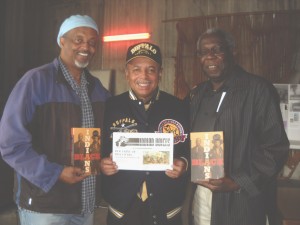 One of the founding myths of this country is that world liberty began in 1776 with the Minute Men at Concord bridge, the Declaration of Independence and Thomas Jefferson. This neglects the history of maroon resistance by African and Native Americans that ranged from Canada to South America for more than a century before 1776
One of the founding myths of this country is that world liberty began in 1776 with the Minute Men at Concord bridge, the Declaration of Independence and Thomas Jefferson. This neglects the history of maroon resistance by African and Native Americans that ranged from Canada to South America for more than a century before 1776
Those of us who have long labored to bring to the light the long-neglected story of maroon resistance to invasion and colonization are delighted to celebrate the successful “Operation Suriname: Maroon Day” that united the living relatives of North and South American maroons this October. Their intrepid ancestors were our first freedom-fighters, and in many instances they also became self-liberated people and forces of resistance within their home countries
“I wanted to build Cultural Bridges to other Black Indian and Maroon Freedom Fighters in the Diaspora” said Da Pompey Fixico who represented the maroons of North America. Fixico. Now President of the Semiroon Historical Society, he has devoted his life to spreading the word in Blogs and articles, speaking at events, meetings, and on radio often with William Loren Katz whose book, Black Indians: A Hidden Heritage (Atheneum, 201200), he calls “a classic.”
The successful Maroon Day organizer was Her Excellency Dr. Ambassador Fidelia Grand-Galon who invited Pompey Fixico and the other delegates to Suriname, a country of half a million people and 120,000 maroon descendants of enormous ethnic diversity. The 2015 National Celebration of Maroon Day recognizes the 255th Anniversary celebration of the “Peace Treaty” signed in 1760 by the Dutch Colonizers in favor of the Maroons, who won their Freedom from the Dutch oppressors through arduous combat and also won the land that they resided on.
Fixico, an honored guest of and accompanied by Ambassador Extraordinary Plenipotentiary, Dr. Fidelia Graand-Galon has written movingly about the experience: “Deep in the Rain forest I visited Proud Maroon People in 10 different villages, on two major rivers both the Tapanahony/Ndyuka and the Cottica River. The villages visited were : 1. Diitabiki 2. Dataa Konde 3. Sanbedum 4. Loabi 5.Pikinpiisii and Kisai (all on the Tapanahony River) 6. Wanhatti 7. Agitii-ondo 8. Lantiwei 9. Pikisant 10. Langa-uku (all on the Cottica River). In addition these villages I was invited — with Ambassador Extraodinary Plenipotentiary, Dr. Fidelia Graand-Galon, I get to see Maroon War Sites and other Secret Sacred places that must not be spoken about.’
We all salute Maroon Day organizers who have for the first time bought together maroon descendants from all of the Americas.
{ 3 comments… read them below or add one }
http://escholarship.org/uc/item/58m7x8mn
https://www.youtube.com/watch?v=nrZCFL-uwQ4
https://www.youtube.com/watch?v=WNltcOusnuA
{ 2 trackbacks }